There are no easy answers for the dilemma of barbed wire and its effects on wildlife and even domestic animals, especially if you’re a farmer or rancher. But we can certainly improve our track record if we realize there’s a problem. A big one.
Some veteran followers of Feathered Photography may be disappointed with today’s post because you’ll have seen many (though not all) of these photos before, some of them more than once. But a comment exchange I had with Judy Gusick on yesterday’s post reminded me that I’ve wanted to publish a post like today’s for several years now so I decided to do it while it’s on my mind. I’ll explain my reasoning for doing so in more detail at the conclusion of this post.
As many of you know I’ve documented a variety of nasty encounters between wildlife and barbed wire over the years and the photos below summarize and condense some of what I’ve seen. There have also been others where I didn’t take any photos for a variety of reasons. I’m going to try to keep my narrative as brief as I can because the images speak for themselves.
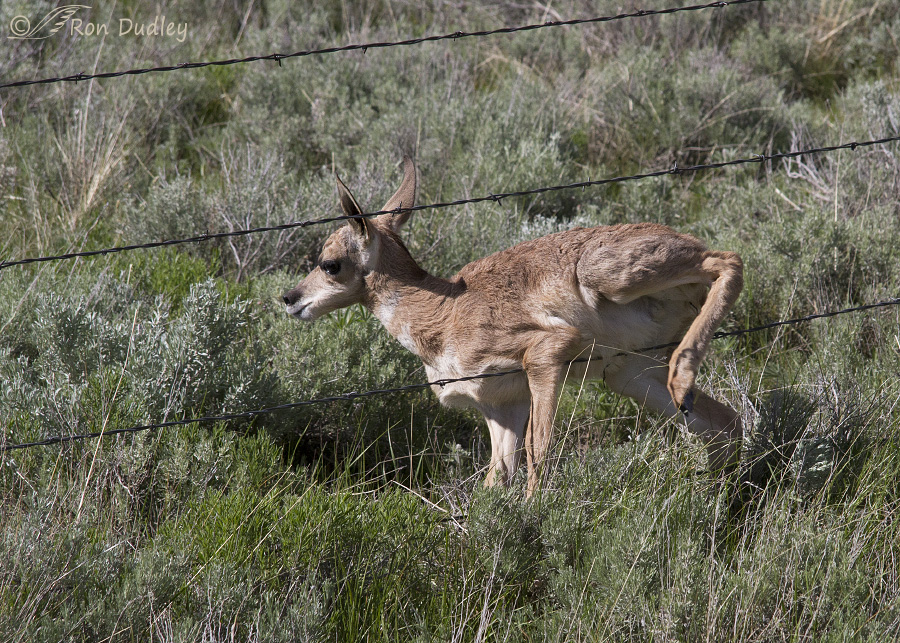
A pronghorn fawn snagged on a single barb of barbed wire under its left front armpit in Montana’s Centennial Valley. When I released the feisty fawn from the wire “he” wasn’t injured and ran briskly to his mother. He thanked me with a swift kick to my right arm as I released him and I was delighted to receive it.
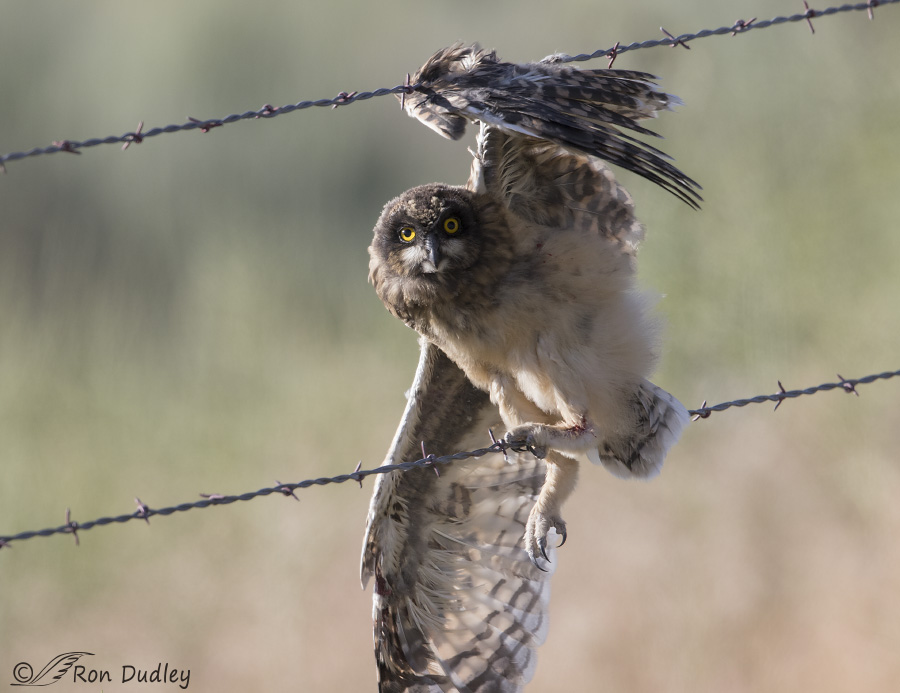
A juvenile male Short-eared Owl hung up on barbed wire in Box Elder County, Utah. I had to cut the wire to get him extricated and then he was delivered to the Wildlife Rehabilitation Center of Northern Utah (WRCNU) where he was rehabbed for many months but because of his wing injury (obvious in the photo) he couldn’t be released back into the wild. So he’s now an education bird for HawkWatch International.
His name is Galileo.
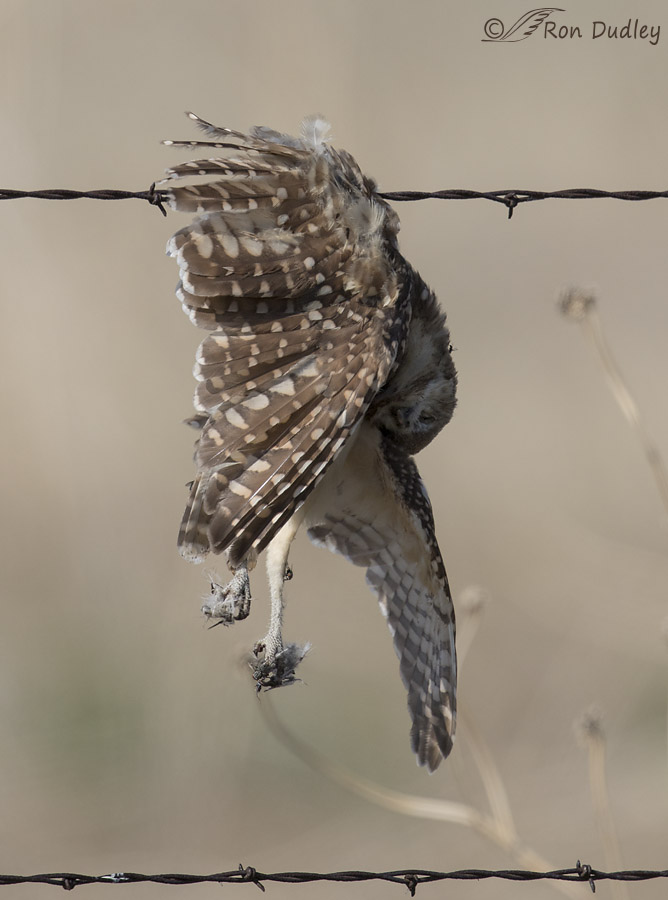
A dead Burrowing Owl hanging from barbed wire in roughly the same area where we rescued Galileo. The talons of this bird are filled with what must be its own feathers, presumably pulled out of its body in the struggle to escape from the wire. Sadly this is the end result of most encounters between birds and barbed wire.
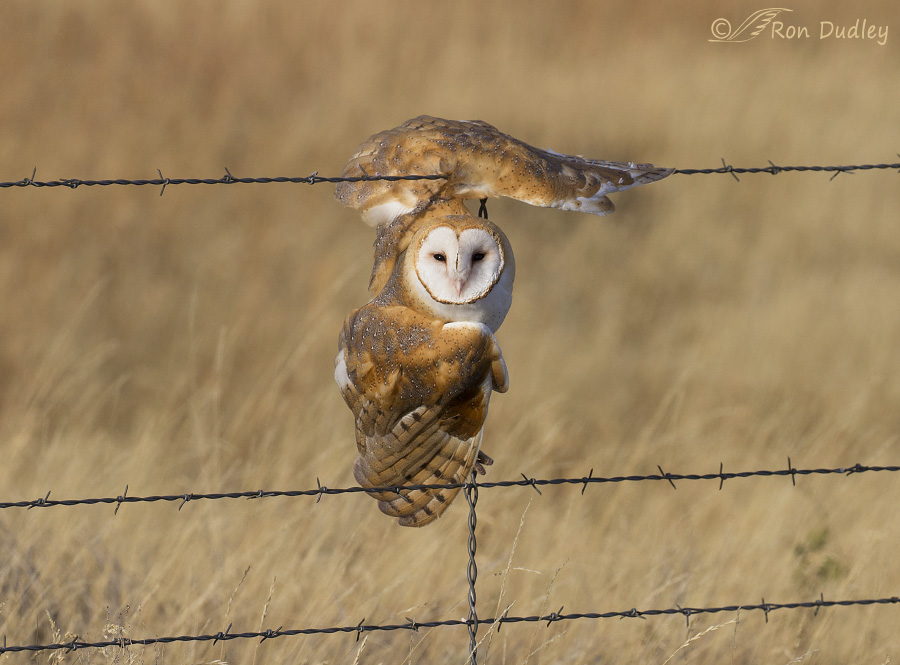
A spectacularly beautiful Barn Owl snagged by barbed wire in Montana’s Centennial Valley. I had to cut the wire for this bird too. The owl was delivered to the Montana Raptor Resource Center (MRRC) in Bozeman where it was rehabbed for several months before being released back into the Centennial Valley.
This was one of the few Barn Owls ever seen in the state of Montana so I was ecstatic that it was released back into the wild where we originally found it.
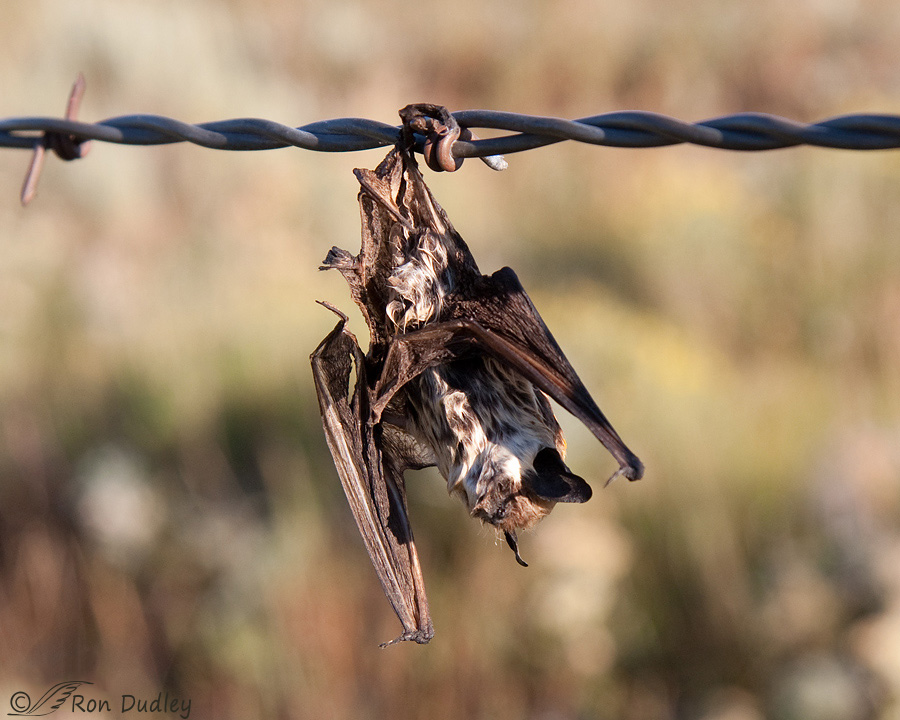
Barbed wire is nasty for almost any wild or domestic animal that has a serious encounter with it and that includes bats. I photographed this dried bat hanging from a single barb, also in the Centennial Valley. This older version of the photo is a little over-sharpened but I didn’t have time to look for the original file and work up another one.
My point is that barbed wire is truly nasty, evil stuff for critters of all kinds and I just wish it would go away or had never been “invented” in the first place. In previous posts we’ve all discussed some alternatives, included barbless wire, barbed wire with fewer barbs, electric fences, fences other than wire fences and a few others. Wire fences of any kind, barbed or not, are deadly to fast-flying birds, especially larger ones like Sage Grouse.
When I’ve posted some of these photos previously they’ve always been in separate posts separated by time so most folks who may stumble across one of them by using search engines like Google won’t get the full impact that I hope this edition of Feathered Photography delivers. With multiple examples in the same post of many individuals and species being devastated by that damned wire and documented by a single person I hope it has more impact. If I alone have seen this many examples (and I’ve seen many more than just these), how many are there really?
It’s my hope that this post will be seen by more non-followers of my blog than usual because of the many species involved and careful choice of my search engine “tags”. And maybe, just maybe, the impact of this many critters being devastated by the devil wire will have some small effect on reducing the use of barbed wire over time.
I can only try.
Ron
Note:
I have to include one last photo because the experience it documents has affected my visceral reaction to barbed wire even though it isn’t the “fault” of the wire. I have the reaction simply by association.
There’s a breed of westerner that I’m deeply ashamed of – the low-brow sickos that like to kill animals, especially predators, and hang them on barbed wire fences as some kind of sick trophy for all who pass by to see. They do it with coyotes especially but any predator will do, including bobcats and they’ve traditionally done it with wolves and mountain lions in the past. They’ve even done it with raptors and they do it proudly.
The photo below is graphic and gut-wrenching. Some will wish they hadn’t seen it, especially those who have a fondness for cats. So please, scroll no further if there’s any possibility that you’ll wish you hadn’t.
You have been warned repeatedly so please, no complaints.
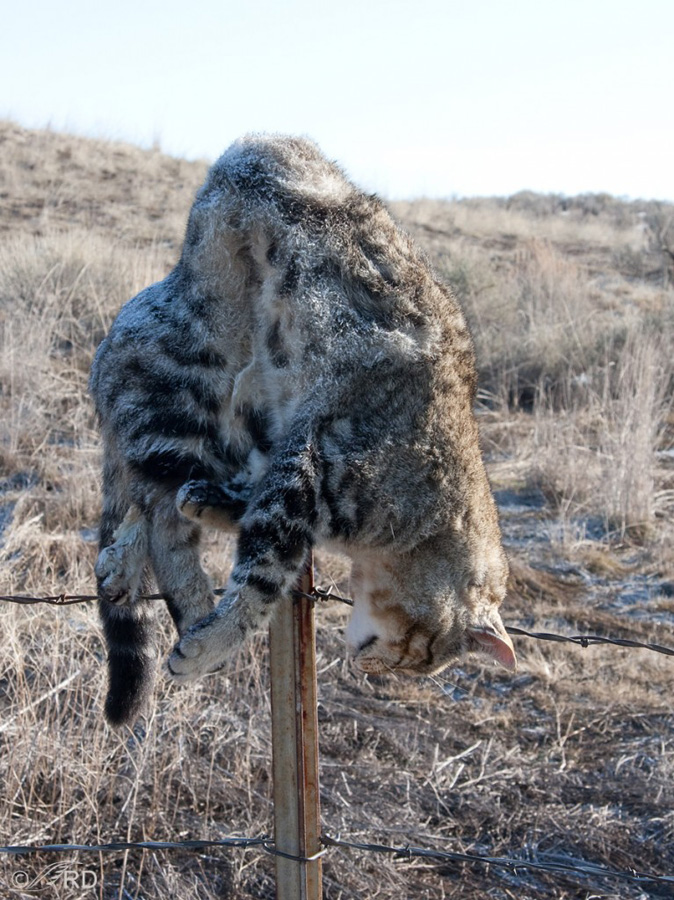
Someone had shot this apparently feral cat and impaled it on a fence post supporting barbed wire in a remote area of Box Elder County. But if you can believe it the entire scene was much more gruesome than this. They’d also shot two more cats, two red foxes and a raven and strung them up in a nearby tree. And there was a dead coyote hanging on a fence just down the road.
Yes, the incident was reported to authorities. More photos and details can be found here if you have the interest and the stomach for it but once again I warn you – the photos are graphic and the incident disturbing, even though there’s no blood and guts to be seen. Proceed to that link with caution.
Obviously this wasn’t the fault of barbed wire, instead it was the fault of assholes, pure and simple. But even though it isn’t logical I can’t help associating this scene with barbed wire because the degenerates who do this kind of thing use barbed wire as a tool of their trade. So I wanted to openly admit up front that the experience might color my negative reaction to barbed wire.
It’s an association I simply can’t avoid making.


You have touched on the rabbit hole I feel I have been in for some time now. Working in rehab I have seen things I can not unsee.
I’ll bet you have, April. I can only imagine.
OK, you have already said/shown many of the things that I feel toward man’s inhumanity to wildlife, so I won’t go into my diatribe, except to thank you for talking and showing images about it.
Unfortunately we belong to a species whose many members think only of themselves and not what effect and affect they might have upon the environment and the wildlife that lives in it.
Many thanks for sharing!
A view you and I have long shared. Thanks, Dick.
Thank you Ron and Ed for some important information this morning. Very sobering, indeed, what our “enlightened” species has done and continues to do.
Thank you, Marty.
Just last May, we were up around Cedarville. While we were checking into our hotel, I noticed a flier by the register, advertising a coyote killing contest just over the border in Nevada. Somewhere along our birding route the next day, there were two coyotes hung on a barbed wire fence, the mark of a cowardly asshole who feels he can shoot anything he wants.
Just remembering that scene was enough to send my blood pressure up.
I’ll bet, Catherine. It would have had the same affect on me.
Powerful post and being a westerner I’ve seen creatures impaled as well. If it was meant to keep creatures in I believe we would have seen more of those creatures impaled and not the wildlife. Maybe I have just missed something but I think not. Sorry you have seen more than your share. Keep up the campaign and be safe out there. It seems there are more human miscreants than ever before.
Betty, cattle in particular don’t challenge barbed wire as often or as aggressively as many wild animals do. At least that’s been my experience.
Phew! Yes I read to the end and the anger is boiling up in me. I have never seen this disgusting act to this extent but I’m certain there are these rednect assholes everywhere.
I am going to share and repost your blog from today, with the warnings, of course.
Some days are downers, especially when you find acts like this against nature.
Share away, Judy. The more folks that see this the better, despite its unpleasantness.
Heartbreaking.
I suspect barbed wire has become a habit. A habit that people don’t think about any longer to wonder whether there are better alternatives. And I am sure there are.
Good point about the habit, EC. Wish I’d made it in my post.
Thanks for documenting these things and being there to save those animals. Maybe it will get some ranchers to reconsider their approach to “good neighbors, good fences.”
The low-brow sickos you describe are indeed just trophy hunters by another name. I can only hope that evolution will eliminate this and other manifestations of the dark side of humankind.
“I can only hope that evolution will eliminate this and other manifestations of the dark side of humankind.
I wish for the same thing. Thanks, Lyle.
All this sickens me, but I am glad you rescued what you could. I too saw a horse caught up in the wire. It had to be put down as it broke a leg trying to free itself.
Donna, in my fairly limited experience horses fight wire more than most other domestic animals when they’re caught in it. And it’s a battle they usually lose and pay a huge price for.
Outstanding series Ron although painful to see. And thank you for taking the time to rescue some of these creatures and see that they got to places where they will be cared for. I must confess that I know very little about farming or ranching although where I now live we have ranches and farms in abundance. I would guess that barbed wire fencing is used more to keep cattle and livestock in rather than predators out. Obviously barbed wire does not stop coyotes, wolves, bobcats, foxes, and mountain lions from coming in. I will have to learn more about the use of barbed wire and other alternatives that are being used here. The pronghorns here do share ranch land with cattle and very possibly some of our ranchers here have installed non-barbed wire on the bottom rung so that the pronghorns can crawl under. It is a shame that our fastest land animals of North America don’t want to jump fences when our mule deer do it with such ease. I was driving up to one of our lakes very early on Saturday morning and five mule deer came down from the hills to my right and then crossed while I stopped and then so effortlessly cleared the high guardrails on the other side. Very educational post for those of us who grew up in cities and suburbia. Thanks Ron.
Everett Sanborn, Prescott AZ
You’re right, Everett – barbed wire fencing has very little deterrent effect on predators, if any. In fact I’ve always wondered if the fences don’t attract predators. After all, most predators are smart – they have to be.
Here is a good reference for those interested.
Excellent reference, Ed – many fence types many problems………..
Yes, that’s an excellent and very detailed reference. I remember seeing it before. So others know, it’s title is “Fencing With Wildlife In Mind”. Thanks for providing it, Ed.
A powerful message well delivered. The wheels of progress grind slowly and need much pushing. Thanks for pushing for all of us. Let’s all keep pushing.
“Let’s all keep pushing.”
Exactly, Dave. I guess that’s about all most of us can do but failing to try just isn’t an option for many of us. I hope to recruit more advocates of fence improvement.
Animals trapped in barbed wire is truly a tragic situation and I HATE it – seen it more than once in the “too late” stages – also seen it in woven wire and bird netting tho certainly not as frequently. 🙁 As you know I also have an appreciation for the economics and effectiveness of barbed wire to contain cattle in particular. The latter group of evil folks I’d like to tangle in a ball of it and “watch” – not really, BUT. Killing just to be killing and having to “display” their “prize” is sickening tho at least the critters aren’t struggling for however long in the wire. No easy answers for sure……
Judy, I’ve seen a horse caught up in barbed wire and fighting it. I’ll never forget it…
Seen photos of that at the Vet’s – horses thin skin makes it even more tragic……. 🙁
Ron, your photos of these terrible encounters with barbed wire, and the last one of the cat are very powerful and as they say, “a picture is worth a thousand words”. Hopefully, these photos will live on forever and convince people of the dangers of barbed wire. Thank you!
The predicted reaction of some will be, “well we need to keep our livestock in…”, fine, use non-barbed wire, electric fencing, or other proven means. Too much of our non-sense today has to deal with social identity, “how dare anyone attack the **image** of the cowboy”. Identity seems to be the biggest influence on change, resisting change. Ranchers who are able to use safer means of enclosing their livestock are brave and smart. They are not sheeple.
On a more promising, and positive note, I have seen more and more wire removal programs on lands where livestock is no longer being held. Places like wildlife refuges and public lands. The removal of the wire fencing is a lot of work, however, it is being done. I have also noticed some ranches where the lowest strand on the fence is non-barbed wire, so pronghorn can crawl under. Electric fencing I am seeing more of too, including its ability to be moved to different parts of the pasture to better manage grazing. This is movement that I think will continue in the right direction.
It will take a long time, however, we have to start somewhere. The task is huge though. Are there any non-profits that focus on fence removal?
Ed, I see a few of the fence “improvements” you mention in the Centennial Valley and elsewhere but as you say it’s a huge job and it’s also an expensive one.
I agree with your point about “the image of the cowboy”. In this day and age they’ve gotta get past that!
I am reminded of one of the tasks my daughter did when she was in Americorps in 2003. In addition to tornado clean-up in Oklahoma, rehabbing a Boys and Hirls Club in Denver , and other projects, her group took down fences on public land
in Colorado that was elk habitat.
The other image that comes to mind is the several Shrikes I have seen with their prey impaled on barb wire…an advantageous adaptation to human presence to be sure…however, not worth the deadly disadvantage to other species,
I agree with your views on shrikes, Linda. One of the few advantages of barbed wire to wildlife but not worth it.